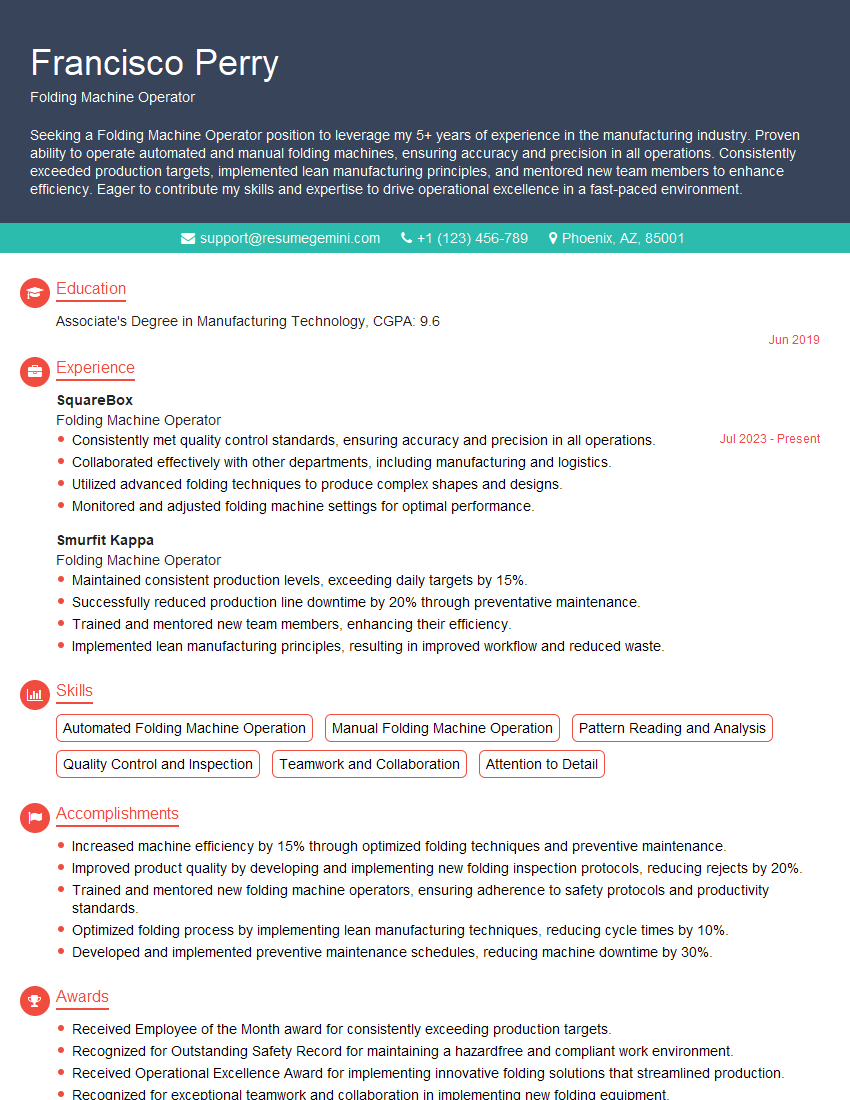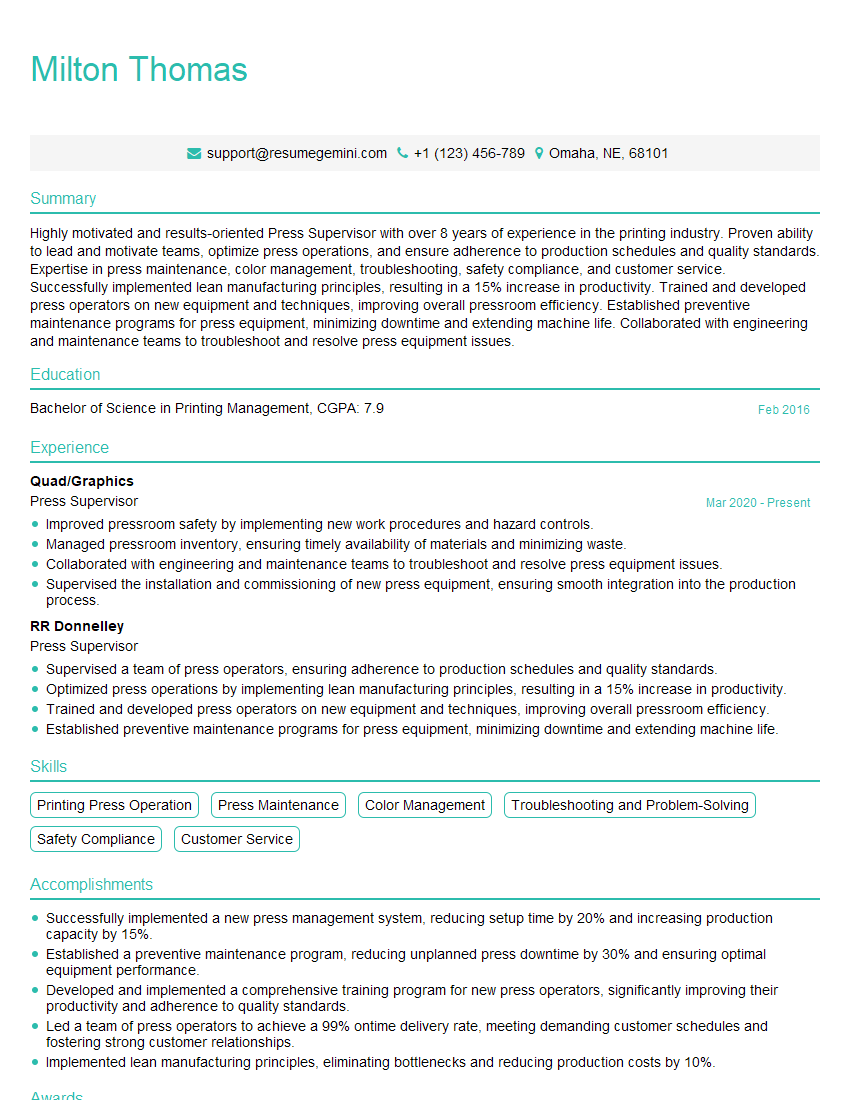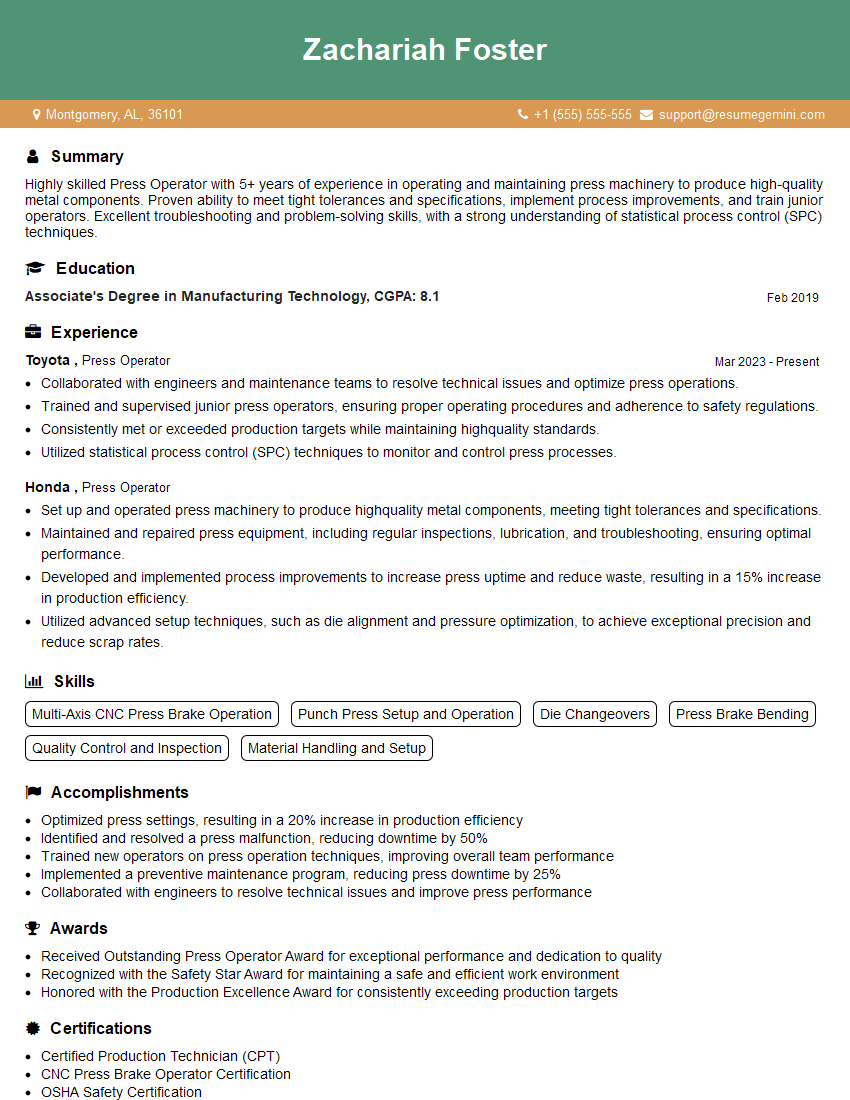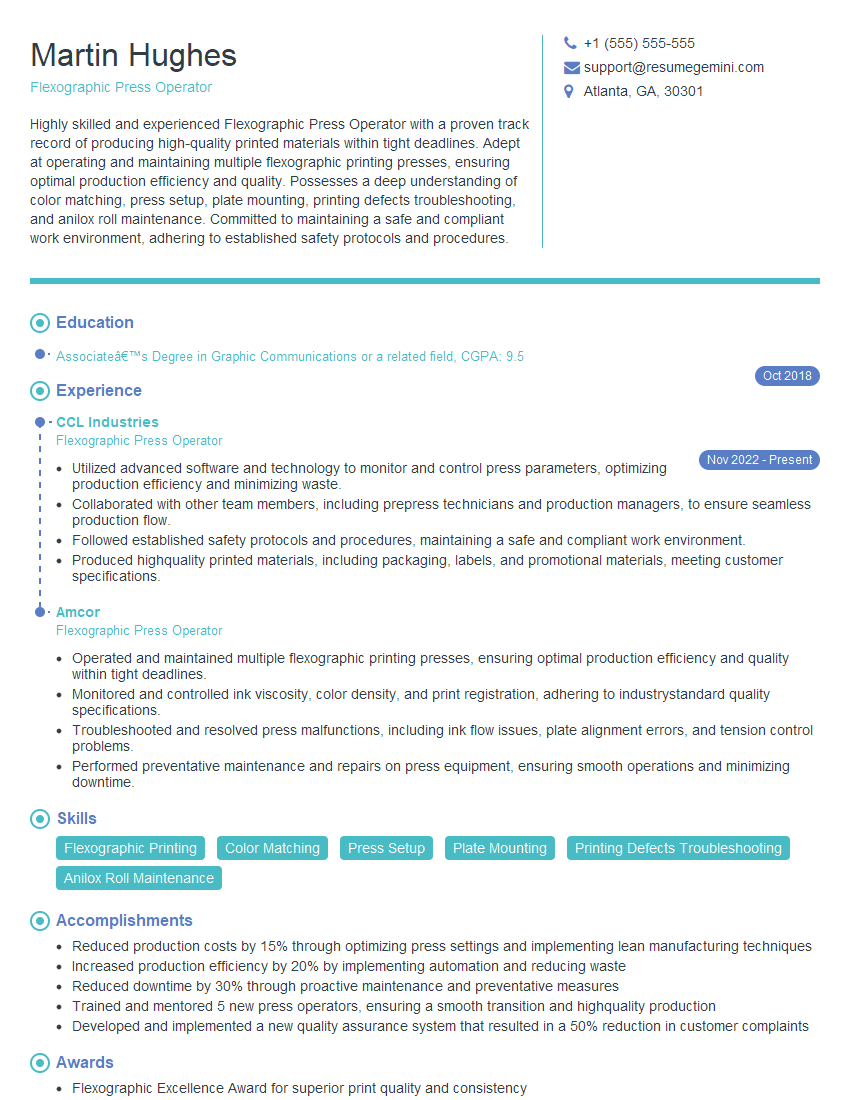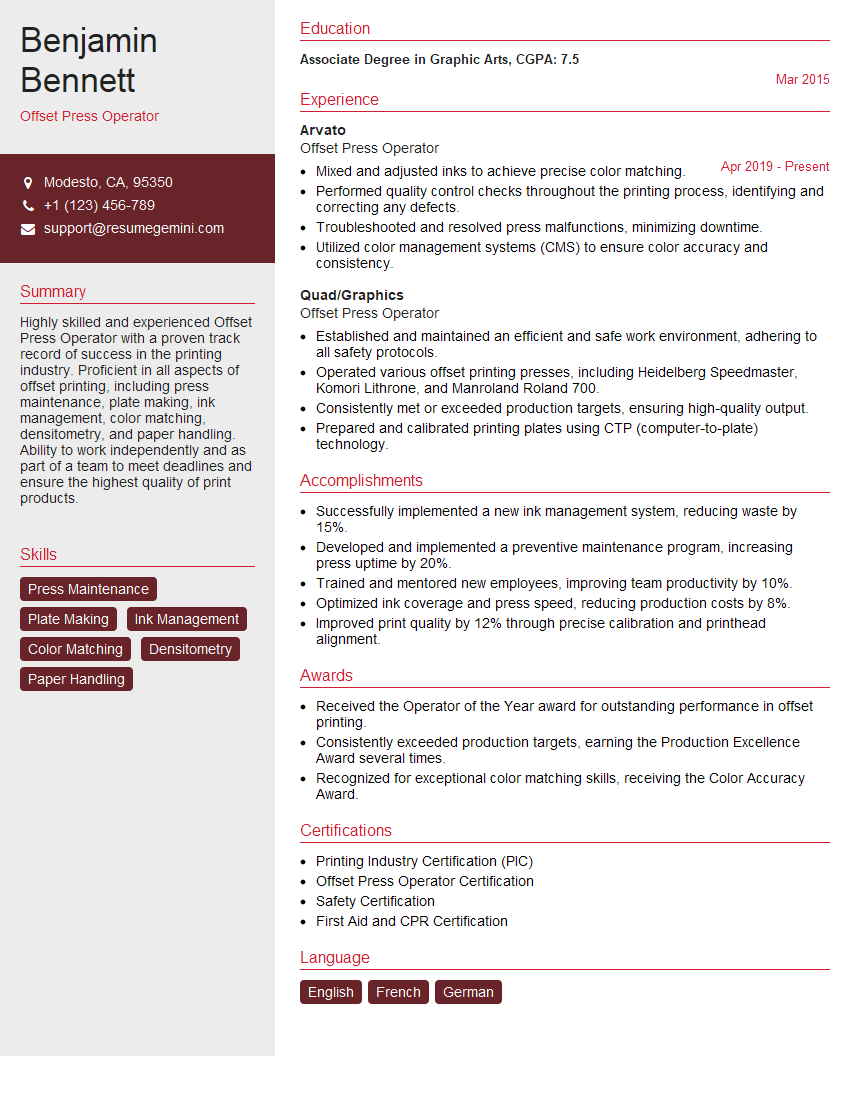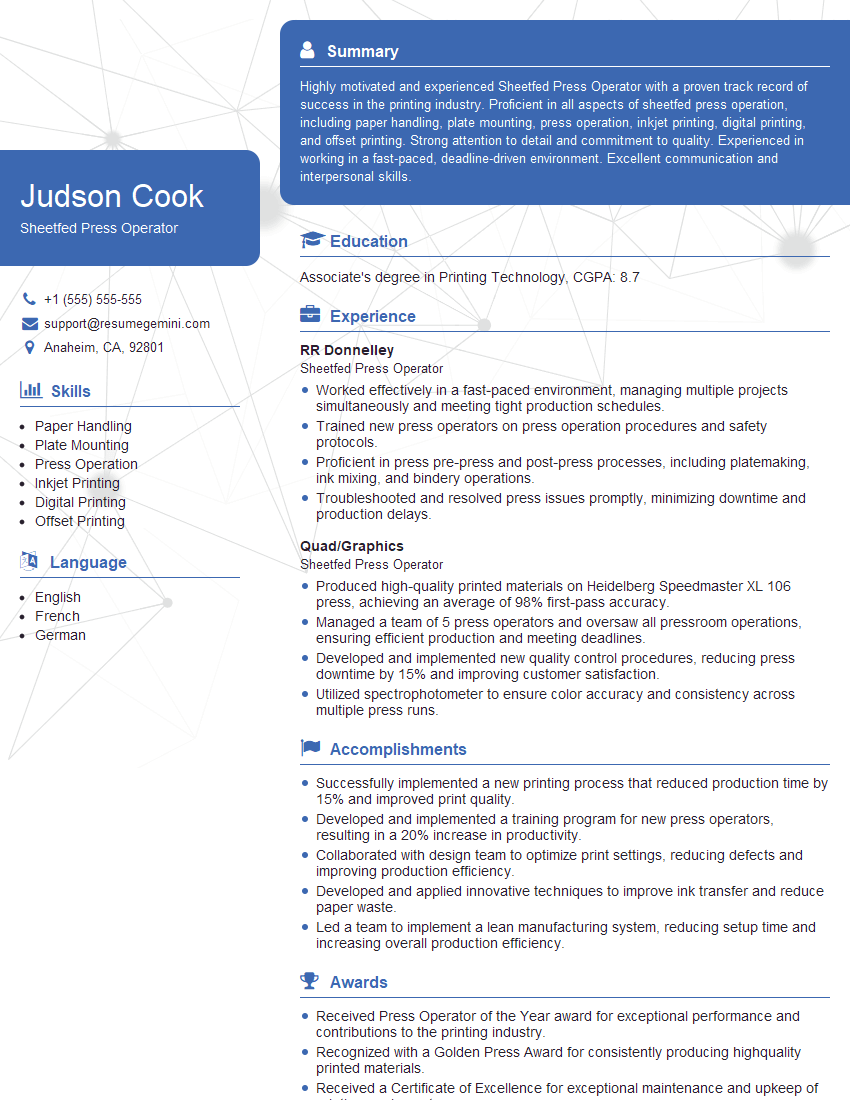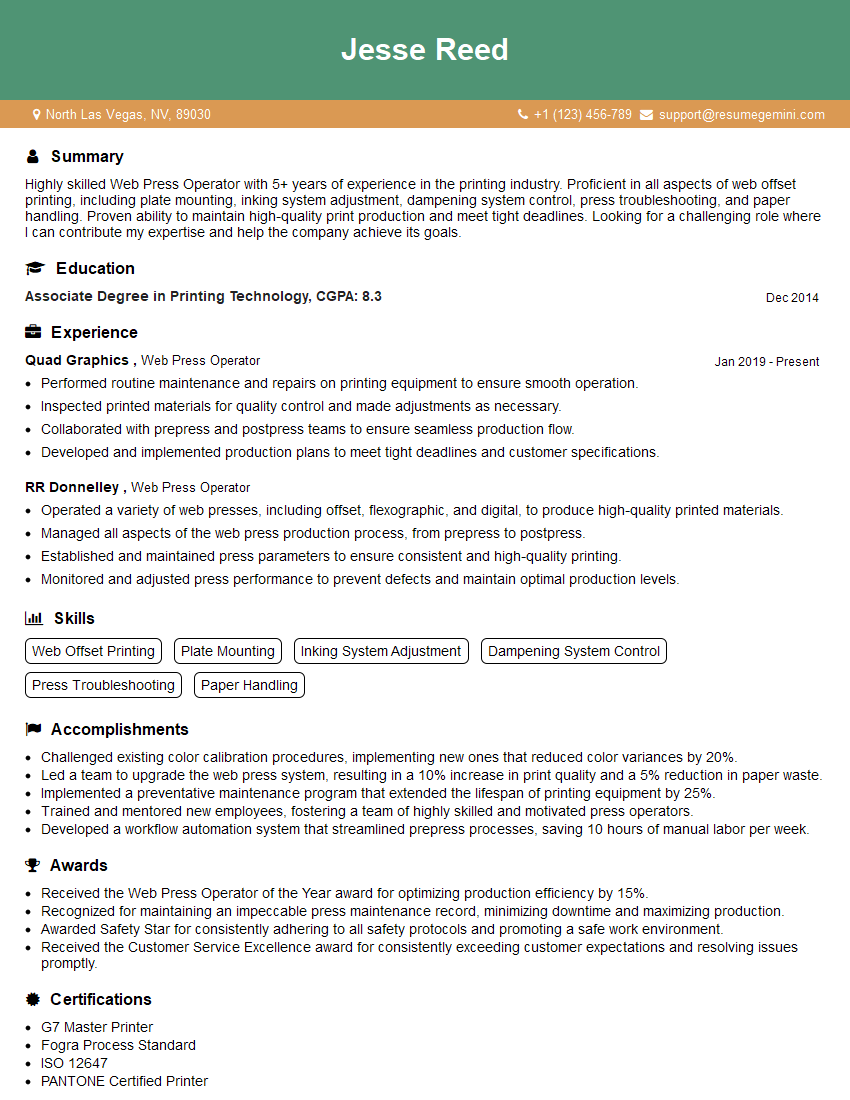The thought of an interview can be nerve-wracking, but the right preparation can make all the difference. Explore this comprehensive guide to Operating and Monitoring Presses interview questions and gain the confidence you need to showcase your abilities and secure the role.
Questions Asked in Operating and Monitoring Presses Interview
Q 1. Describe your experience operating different types of printing presses.
My experience encompasses a wide range of printing presses, including sheet-fed offset presses (both small and large format), web offset presses, and digital printing systems like inkjet and toner-based presses. I’ve worked extensively with Heidelberg Speedmaster and Komori Lithrone presses, for example, gaining proficiency in their unique functionalities and maintenance requirements. Each press type presents distinct challenges and opportunities. Sheet-fed presses excel in short-to-medium runs and high-quality color reproduction, while web offset is ideal for high-volume printing of newspapers or magazines. Digital presses offer incredible flexibility and speed for smaller runs and personalized marketing materials. My expertise lies in adapting my operating techniques to the specific capabilities of each machine.
Q 2. Explain the setup procedure for a typical printing job.
Setting up a typical printing job involves a meticulous process, beginning with pre-flighting the digital files to ensure they meet print specifications. This includes checking resolution, color profiles, and bleed areas. Next, I’ll create a press sheet layout, optimizing the placement of individual jobs to minimize waste. Then, I make the necessary adjustments to the press itself, such as selecting the correct paper stock, ink type, and setting the printing plates. This includes fine-tuning the ink keys and adjusting the dampening system for optimal ink-water balance. A crucial step is the color calibration process – running test prints and making adjustments to achieve accurate color matching with the provided proofs. Finally, I run a test sheet and make any necessary adjustments before starting the full production run. Think of it like baking a cake: you need the right recipe (pre-press), the correct ingredients (paper, ink), and precise measurements (press settings) to ensure a perfect result.
Q 3. How do you ensure consistent color accuracy on a press run?
Consistent color accuracy is paramount. I achieve this through a multi-faceted approach starting with accurate color profiling of the press and the paper stock. This involves utilizing spectrophotometers to measure and compare the color values against target values provided by the client’s proof. I use color management software to control color profiles throughout the workflow. Regular color checks throughout the run, using color bars and control strips, are crucial to detect and correct any drift in color. Factors like ink viscosity, temperature, and humidity also affect color, so monitoring and maintaining these are essential. Think of it like tuning a musical instrument: consistent monitoring and small adjustments are crucial to maintaining a perfect pitch.
Q 4. What are the common causes of paper jams, and how do you troubleshoot them?
Paper jams are unfortunately common. Causes often include incorrect paper feed settings, such as a misaligned paper stack or improper paper registration. Other potential causes include damaged or excessively humid paper, debris in the feeder or delivery system, and improper roller adjustments. My troubleshooting method begins with a visual inspection, carefully checking each component along the paper path. I’ll then adjust the paper feed, clean any debris, and check for worn or damaged rollers. If the problem persists, I’ll consult the press’s maintenance manual and might call for a technician if needed. Often, a simple adjustment, like tightening a roller or cleaning a sensor, quickly solves the problem. It’s similar to troubleshooting a computer issue – systematic investigation is key to finding the root cause.
Q 5. Describe your experience with pre-press and post-press operations.
My experience extends beyond press operation to include pre-press and post-press processes. In pre-press, I’m familiar with file preparation, color management, and platemaking. I understand the importance of proper trapping and imposition to ensure efficient print production. Post-press processes like cutting, folding, binding, and finishing are critical to the final product quality. I’m proficient in operating various finishing equipment, ensuring consistency in the overall look and feel of the printed material. A complete understanding of the entire workflow, from digital file to finished product, is essential for efficient production and problem-solving.
Q 6. How do you maintain the quality of printed materials throughout the production process?
Maintaining quality is a continuous effort throughout the production process. It begins with rigorous quality control checks at each stage, starting from pre-press file inspection and continuing through press monitoring and post-press finishing. I use standardized quality control measures and regularly monitor color consistency, paper alignment, and overall print quality. Regular maintenance of the press and timely replacement of worn parts contribute significantly to maintaining consistent quality. Careful handling of materials is also vital. This holistic approach ensures the final product meets the required standards.
Q 7. What safety measures do you follow when operating printing presses?
Safety is my top priority. I always follow lockout/tagout procedures before performing any maintenance on the press. I wear appropriate personal protective equipment (PPE) such as safety glasses and gloves. I regularly inspect the press for any potential hazards, paying close attention to moving parts and electrical connections. I am trained in emergency procedures and know how to react safely in case of a paper jam or other unexpected event. A safe working environment is crucial for productivity and prevents injuries. Safety isn’t just a protocol; it’s a mindset that guides all my actions while operating the press.
Q 8. How do you identify and address ink and paper issues during a press run?
Identifying and addressing ink and paper issues during a press run is crucial for maintaining print quality and efficiency. It involves a systematic approach, starting with careful observation and moving to targeted solutions.
Ink Issues: Problems like uneven ink distribution (mottle), excessive ink build-up (hilling), or insufficient ink (pale areas) are common. I diagnose these by examining the printed sheets closely, checking the ink keys on the press, and analyzing the ink fountain settings. Solutions range from adjusting the ink fountain rollers to cleaning the rollers, replacing the ink, or making fine-tuning adjustments to the ink duct settings. For example, if I see mottle, I might first check the ink viscosity and then adjust the ink roller settings to ensure even distribution. If the problem persists, I’d examine the rollers for damage or cleaning needs.
Paper Issues: Paper issues can include wrinkles, misfeeds, static cling, or variations in paper absorbency. I address these by inspecting the paper stack for inconsistencies, checking the paper path on the press for obstructions, and adjusting the paper feeders and tension settings. For instance, wrinkles could indicate insufficient paper tension, which can be resolved by adjusting the tension controls. Static cling can be resolved through the use of anti-static solutions or equipment. Variations in paper absorbency might require adjusting the ink density accordingly.
Ultimately, proactive monitoring and regular checks are essential. I often take a small sample print throughout the run to ensure the quality remains consistent.
Q 9. Explain your experience with different types of inks and their application.
My experience encompasses a wide range of inks, including UV inks, conventional solvent-based inks, water-based inks, and vegetable-based inks. Each type demands a different approach to application.
- UV (Ultraviolet) inks cure instantly when exposed to UV light, offering quick drying times and vibrant colors. However, they require specialized equipment, and their viscosity needs careful monitoring.
- Solvent-based inks offer excellent print quality and adhesion but have strong odors and require proper ventilation. Understanding the specific solvent is crucial for adjusting viscosity and avoiding problems.
- Water-based inks are environmentally friendly and have less odor, but they can be less vibrant and require careful control of humidity levels. Understanding the effects of paper absorbency on color development is critical.
- Vegetable-based inks are environmentally friendly, but careful monitoring is needed as these inks can dry slower than others and require different paper types.
Applying these inks involves understanding the press’s specific ink delivery system and the ink’s properties. For instance, viscosity is critical; too thick, and the ink won’t flow properly; too thin, and it will lead to pale prints. I’ve found that a systematic approach – considering the ink type, substrate, and desired result – is crucial for a successful application.
Q 10. How do you monitor and adjust ink density and registration on a press?
Monitoring and adjusting ink density and registration are critical for consistent, high-quality printing. It’s a continuous process requiring attention to detail and the use of various tools and techniques.
Ink Density: I use a densitometer to measure the ink density on the printed sheets. This instrument measures the optical density of the ink, providing a numerical value that indicates the ink’s concentration. I compare these measurements to the target values specified by the job requirements. Adjustments involve modifying the ink fountain settings, roller pressures, and ink duct settings. It’s important to make small incremental adjustments and continuously monitor the results.
Registration: Registration refers to the precise alignment of multiple colors or elements on a printed sheet. I monitor registration using a registration gauge or by visually inspecting the printed sheets. Misregistration can result from issues with the press’s feeding system or gripper bars. Corrections involve adjusting the plate cylinder, impression cylinder, and sidelay settings on the press. Fine tuning these adjustments requires both precision and a practiced eye for detail.
The process is iterative. I continuously monitor both ink density and registration throughout the press run, making necessary adjustments to maintain consistency. This continuous monitoring ensures the final output meets the required quality standards.
Q 11. Describe your experience with press maintenance, including cleaning and preventative procedures.
Press maintenance is paramount for ensuring the longevity and efficiency of the equipment. My experience covers a wide range of maintenance tasks, encompassing both cleaning and preventative measures.
Cleaning: Regular cleaning is essential to prevent ink build-up, paper dust accumulation, and other contaminants that could impact print quality and cause malfunctions. This includes daily cleaning of rollers, ink fountains, and the paper path. More thorough cleaning, including disassembling certain components, is conducted at scheduled intervals, such as weekly or monthly, based on the press’s usage and the type of inks used.
Preventative Maintenance: This involves scheduled lubrication, inspection of key components (such as bearings, gears, and motors), and preventative replacements of worn parts. I maintain detailed records of all maintenance activities and inspections, using these logs to track potential issues and predict maintenance needs. This proactive approach minimizes downtime and maximizes press efficiency.
For example, I’ve found that meticulously cleaning and lubricating the impression cylinder regularly prevents premature wear and tear, significantly extending its lifespan. This is far more cost-effective than dealing with a broken cylinder midway through a large print job.
Q 12. What are the key performance indicators (KPIs) for a printing press, and how do you monitor them?
Key Performance Indicators (KPIs) for a printing press help assess its efficiency and overall performance. I regularly monitor several critical KPIs:
- Uptime: The percentage of time the press is actively running, excluding downtime due to maintenance or malfunctions. I track this using production logs and maintenance records.
- Speed: The press’s printing speed, measured in impressions per hour (IPH) or sheets per minute (SPM). This is a direct indicator of productivity.
- Waste: The percentage of printed sheets that are considered waste due to defects or errors. Minimizing waste is crucial for cost-effectiveness. I monitor this through detailed waste logs.
- Ink Consumption: The amount of ink used per job or per unit of printed material. Efficient ink management is key for cost control.
- Paper Waste: Similar to ink waste, monitoring this helps identify issues within the paper handling process.
- Cost Per Impression: Calculation of the overall cost of producing a single impression, factoring in materials, labor, and energy.
I use data analysis techniques and reporting tools to visualize these KPIs and identify trends or areas for improvement. For instance, a consistently high waste percentage might indicate a problem with the feeder mechanism or a need for operator retraining.
Q 13. How do you handle press malfunctions and downtime?
Handling press malfunctions and downtime requires a structured approach focused on quick diagnosis and effective problem-solving. My strategy involves:
- Immediate Assessment: Identify the nature and severity of the malfunction. Is it a minor issue or something that requires extensive repair?
- Safety First: Prioritize safety by shutting down the press and ensuring the area is secure before attempting any repairs.
- Troubleshooting: Consult the press’s technical documentation, schematics, and error codes. If the problem is not immediately evident, systematically check all relevant components, starting from the most likely causes.
- Communication: If the problem is beyond my expertise, I communicate the issue to the appropriate technical support personnel.
- Documentation: Record all actions taken, including troubleshooting steps, parts replaced, and time spent on repairs. This documentation is crucial for preventative maintenance.
- Preventative Measures: After resolving the issue, analyze the root cause to identify any preventative measures that can be implemented to avoid future occurrences.
For example, if a misfeed keeps occurring, I might check the paper path for obstructions, inspect the feeder rollers, and adjust the paper tension. If these steps fail to resolve the issue, I might consult the technical manual or contact the manufacturer for assistance.
Q 14. Explain your experience with troubleshooting complex press problems.
Troubleshooting complex press problems often requires a methodical and systematic approach. I leverage my experience and problem-solving skills in the following ways:
- Gather Information: Start by collecting all relevant information about the problem. This includes observing the symptoms, reviewing error logs, and gathering input from operators.
- Isolate the Problem: Systematically test individual components to pinpoint the exact source of the malfunction. This might involve testing sensors, actuators, and electrical circuits. I often use a process of elimination to isolate potential areas of failure.
- Diagnose the Root Cause: Once the problematic component is identified, determine the underlying cause of the failure. This may require knowledge of hydraulics, pneumatics, electronics, and mechanical systems. A detailed understanding of the press’s architecture is critical in this step.
- Implement Solutions: Develop and implement solutions based on the root cause analysis. This can involve repairing or replacing damaged parts, adjusting settings, or rewriting control programs.
- Verification and Testing: Thoroughly test the implemented solution to ensure that the press is functioning correctly and the problem is resolved. Observe the press for a period after the fix to ensure it doesn’t re-occur.
I recall one instance where a complex problem with the color registration kept occurring despite numerous adjustments. It turned out a hairline crack in the impression cylinder was causing inconsistent pressure, leading to misregistration. Identifying this crack required careful inspection and a deep understanding of how the pressure system works. Once this was replaced, the problem was resolved.
Q 15. Describe your knowledge of different printing processes (e.g., offset, flexo).
My expertise encompasses a wide range of printing processes, with a strong focus on offset and flexographic printing. Let’s break down the key differences:
- Offset Lithography: This is the workhorse of commercial printing, ideal for high-volume, high-quality projects. It uses a plate-cylinder system where ink is transferred from the plate to a blanket cylinder and then to the substrate (paper, cardboard, etc.). Offset excels in reproducing fine details and halftones, making it perfect for brochures, magazines, and books. Think of it like indirect kissing—the ink doesn’t directly touch the paper.
- Flexographic Printing: This is a relief printing process, meaning the image is raised on the printing plate. Flexo is highly versatile, used for packaging, labels, and flexible substrates like plastic films. It uses flexible photopolymer plates, allowing for faster turnaround times and simpler platemaking. The ink transfer is direct from the raised image to the substrate. Imagine stamping an image—that’s the basic principle.
I’ve worked extensively with both, understanding their strengths and limitations, including ink selection, plate preparation, and press setup and optimization. For example, I once streamlined a client’s offset printing process by implementing a new color management system, resulting in a 15% reduction in waste and a significant improvement in color consistency.
Career Expert Tips:
- Ace those interviews! Prepare effectively by reviewing the Top 50 Most Common Interview Questions on ResumeGemini.
- Navigate your job search with confidence! Explore a wide range of Career Tips on ResumeGemini. Learn about common challenges and recommendations to overcome them.
- Craft the perfect resume! Master the Art of Resume Writing with ResumeGemini’s guide. Showcase your unique qualifications and achievements effectively.
- Don’t miss out on holiday savings! Build your dream resume with ResumeGemini’s ATS optimized templates.
Q 16. How do you work effectively in a team environment to meet production deadlines?
Meeting production deadlines in a team requires clear communication, proactive problem-solving, and a collaborative spirit. I’ve always been a strong team player, believing that success depends on everyone contributing their expertise.
In previous roles, I’ve actively participated in daily production meetings, where we discuss upcoming jobs, potential bottlenecks, and resource allocation. If a problem arises—like a jammed press or a material shortage—I immediately communicate it to the team and work collaboratively to find the quickest solution. For instance, during a particularly tight deadline for a large order of product labels, I coordinated with the pre-press team to ensure timely plate making, while simultaneously communicating with the finishing department to prepare for quick turnaround. Open communication and shared responsibility ensured we delivered on time and to the highest quality.
Q 17. What are the key differences between sheetfed and web presses?
The primary distinction between sheetfed and web presses lies in how they handle the printing substrate:
- Sheetfed Presses: These presses process individual sheets of paper, fed one at a time. They’re ideal for smaller print runs and higher-quality work, offering more precise control over registration and color consistency. Think of it like a carefully controlled conveyor belt handling individual sheets.
- Web Presses: These presses use a continuous roll of paper (the “web”), printing at much higher speeds. They’re better suited for large print runs, such as newspapers, magazines, and large-format packaging. Web presses are like a giant, fast-moving river of paper—they require excellent automation and continuous monitoring.
My experience includes operating and maintaining both types, understanding their specific needs and limitations. For instance, I’ve successfully transitioned a client from sheetfed to web printing for a large magazine project, leading to significant cost savings due to the increased speed and efficiency.
Q 18. How do you interpret and respond to quality control reports?
Interpreting quality control reports is crucial for maintaining consistent output. I meticulously review reports, looking for trends and anomalies. Key metrics include color accuracy, registration, ink density, and dot gain.
A common scenario involves identifying a consistent color shift across multiple sheets. I would first examine the report for details about where the variation is most pronounced (e.g., specific color, area of the sheet). Then I would investigate potential causes, such as ink viscosity issues, incorrect plate setting, or even problems with the paper stock itself. I would systematically eliminate possibilities, adjusting settings or replacing components as needed, and documenting all changes made. This step-by-step approach helps maintain a detailed log and promotes continuous improvement. Once the issue is resolved, I re-run quality checks to confirm the correction.
Q 19. Explain your experience with different types of press controls and automation.
My experience spans a variety of press controls and automation technologies, including PLC-based systems, sophisticated color management software, and automated register controls. I’m proficient in troubleshooting and maintaining these systems, ensuring optimal press performance.
For instance, I’ve implemented and managed automated inking systems that drastically reduced setup times and minimized ink waste. I’m also comfortable with the diagnostic software used to monitor the various components of the press. This allows me to proactively identify potential problems before they cause significant downtime. In one instance, early identification through diagnostic software prevented a catastrophic failure of a critical press component, preventing extensive production delays.
Q 20. How familiar are you with color management systems (e.g., Pantone)?
I’m highly familiar with Pantone and other color management systems. Understanding color specifications and their translation to the press is critical for meeting client expectations. I utilize spectrophotometers to accurately measure colors and ensure consistent reproduction. Pantone matching systems help maintain brand consistency across different projects.
For example, when working on a project requiring specific Pantone colors, I’d use a spectrophotometer to measure the ink on press, comparing it against the Pantone standard. This helps in identifying and correcting any deviations in color, ensuring precise reproduction of the brand colors. This meticulous approach minimizes reprints and revisions, leading to cost-effectiveness and client satisfaction.
Q 21. What are your methods for reducing waste during a press run?
Waste reduction is a critical aspect of efficient press operation. My strategies include:
- Careful pre-press planning: Ensuring accurate imposition and minimizing errors before the press run starts reduces the need for waste sheets.
- Precise makeready: Optimizing press settings during makeready reduces waste during the initial setup phase.
- Efficient ink management: Implementing systems for monitoring and controlling ink usage minimizes waste.
- Regular maintenance: Keeping the press in optimal condition reduces downtime and avoids waste due to malfunctions.
- Data-driven optimization: Utilizing press data to identify and address sources of waste.
For example, I successfully reduced waste by 10% on a long-run project by implementing a new automated cleaning system that reduced makeready times and minimized ink waste during color changes. This shows how even small improvements in press operations can generate significant savings.
Q 22. How do you ensure the efficient use of materials and resources?
Efficient material and resource use in a printing press environment hinges on meticulous planning and execution. It’s not just about saving money; it’s about minimizing waste, reducing environmental impact, and maximizing profitability.
- Pre-press Planning: This is crucial. We start by carefully analyzing the job specifications – the quantity, size, and type of print – to determine the optimal material usage. For example, if a client requests 1000 flyers, we’d carefully calculate the exact amount of paper needed, factoring in potential waste during cutting and finishing. This prevents over-ordering and subsequent waste.
- Waste Reduction Strategies: We implement several waste reduction techniques. This includes using job nesting software to optimize the placement of prints on larger sheets to minimize material scraps. We also maintain a rigorous inventory management system to track material consumption and identify areas where waste is occurring. For instance, tracking ink usage helps us identify and rectify any ink bleed or over-application issues.
- Regular Maintenance: Well-maintained equipment is essential. Consistent maintenance minimizes downtime caused by malfunctioning machinery, which could lead to material spoilage. Regular cleaning of the press, for example, ensures clean, consistent prints and prevents waste from misprints caused by dirt or debris.
- Recycling and Responsible Disposal: We prioritize recycling of waste materials like paper scraps and used ink cartridges, adhering to environmental regulations. Proper disposal prevents environmental contamination.
In my previous role, we implemented a new job nesting software which reduced paper waste by 15% within six months, leading to significant cost savings and a positive environmental impact. This shows how careful planning and implementation of efficient strategies can drastically improve material usage.
Q 23. Describe your experience with different types of printing substrates.
My experience encompasses a wide range of printing substrates, each with its unique properties and printing considerations. Understanding these properties is paramount to producing high-quality prints.
- Paper: I’m proficient with various paper weights, finishes (coated, uncoated, textured), and types (bond, cardstock, specialty papers). The choice depends on the intended use. A glossy coated paper works well for vibrant images, whereas uncoated stock is better for text-heavy documents.
- Cardboard and Paperboard: I have experience with different types of cardboard and paperboard, used for packaging and displays. These substrates require adjustments in press settings due to their thickness and rigidity.
- Vinyl and Synthetic Materials: I’ve worked with various vinyl and synthetic materials, such as banners, signage, and decals. These require specific inks and press settings to adhere properly and ensure vibrant colors.
- Textiles: I have limited experience in textile printing, but I understand the distinct requirements of this specialized area, particularly in ink selection and press calibration.
For instance, when printing on a delicate watercolor paper, I’d adjust the press pressure to prevent damage and ensure proper ink absorption. For thicker substrates like corrugated cardboard, I would adjust the feed and registration settings to accommodate their bulk. This adaptability is crucial to achieve consistent quality across various projects.
Q 24. How do you maintain a clean and organized workspace?
A clean and organized workspace is essential for efficiency and safety. It’s also crucial for producing high-quality prints and preventing errors.
- Daily Cleaning: We clean the press and surrounding area after each job, removing ink spills, paper scraps, and other debris. This prevents ink buildup, ensures smooth operation, and minimizes the risk of fire hazards.
- Regular Maintenance: We perform regular, scheduled maintenance on the press, ensuring that all moving parts are lubricated and functioning correctly. This preventative maintenance helps to avoid unexpected breakdowns and downtime.
- Organized Material Storage: We use a standardized system for storing materials – paper, inks, and other consumables – keeping them organized by type and size. This allows for efficient retrieval and prevents confusion.
- 5S Methodology: We apply the 5S methodology (Sort, Set in Order, Shine, Standardize, Sustain) to maintain a consistently clean and organized workspace. This creates a productive and safe environment.
Implementing these practices not only improves workplace aesthetics but also significantly reduces the chance of errors, improves efficiency, and enhances overall safety.
Q 25. Describe your experience with the setup and operation of different types of finishing equipment.
My experience includes setup and operation of various finishing equipment, which are critical for transforming printed sheets into finished products. This includes understanding their capabilities and limitations for optimal results.
- Cutting Machines: I’m proficient with guillotine cutters and die cutters, used for cutting paper to precise sizes and shapes. Knowing how to adjust the blade height and pressure is critical to achieve clean cuts.
- Folding Machines: I have experience with various folding machines, from simple hand-fed folders to automated high-speed machines. Different folds – letter folds, z-folds, gate folds – require different settings and techniques.
- Binding Machines: My skills extend to different binding methods, including saddle stitch, perfect binding, and wire-o binding. Choosing the correct binding method depends on the project requirements and the number of pages.
- Laminators: I’m familiar with different types of laminators, using both gloss and matte films to protect printed materials and enhance their appearance.
For example, when setting up a die cutter for a complex shape, I’d meticulously check the die’s placement and ensure the press pressure is correctly calibrated to prevent damage to the die or the material. Such precision ensures consistent, high-quality finished products.
Q 26. How do you handle customer specifications and requirements?
Handling customer specifications is a crucial aspect of my role. It requires careful attention to detail and clear communication to ensure the final product aligns perfectly with client expectations.
- Clarification and Confirmation: I begin by carefully reviewing all specifications, including artwork, color profiles, paper type, and finishing requirements. Any ambiguities are immediately clarified with the client to avoid misunderstandings.
- Proofing and Approvals: I provide digital and/or physical proofs to the client for approval before proceeding with the production run. This allows for early identification and correction of any errors.
- Communication: Throughout the process, I maintain open and clear communication with the client, providing updates on the progress of the job and addressing any questions or concerns promptly.
- Problem-Solving: If unforeseen issues arise during production, I communicate them to the client immediately and work collaboratively to find a satisfactory solution.
I remember a project where the client’s initial artwork had a color mismatch. By proactively pointing this out during the proofing stage, we avoided printing a large batch of incorrect materials. This emphasizes the importance of consistent communication and thorough proofing.
Q 27. How do you prioritize tasks to ensure timely completion of jobs?
Prioritizing tasks effectively is key to meeting deadlines and ensuring efficient workflow in a busy printing environment. I use a combination of techniques to manage my workload effectively.
- Job Scheduling: I utilize a job scheduling system to organize upcoming jobs based on their deadlines and complexity. This allows me to plan the workflow efficiently and allocate resources effectively.
- Urgency and Importance: I apply the Eisenhower Matrix (urgent/important) to prioritize tasks. Urgent and important tasks are tackled immediately, while less urgent tasks are scheduled accordingly.
- Workflow Optimization: I constantly look for ways to streamline the workflow and improve efficiency. This may involve identifying bottlenecks or automating repetitive tasks.
- Flexibility and Adaptability: Unexpected issues can arise. My ability to adapt to changing priorities and adjust the schedule accordingly is crucial to meet deadlines.
During peak seasons, this structured approach is especially crucial. For instance, prioritizing rush jobs while still managing longer-term projects ensures that all deadlines are met while maintaining productivity.
Q 28. What steps do you take to ensure workplace safety?
Workplace safety is paramount. A proactive approach to safety prevents accidents and ensures a healthy work environment.
- Personal Protective Equipment (PPE): We consistently use appropriate PPE, including safety glasses, gloves, and hearing protection, depending on the task. This protects us from potential hazards such as ink splashes, paper cuts, and machine noise.
- Machine Safety Procedures: We strictly adhere to all machine safety procedures. This includes using lockout/tagout procedures when performing maintenance or repairs on machinery to prevent accidental starts.
- Housekeeping: Maintaining a clean and organized workspace minimizes tripping hazards and reduces the risk of accidents. Proper disposal of waste materials also contributes to safety.
- Regular Training: We participate in regular safety training sessions, ensuring we are updated on safety regulations and best practices. This includes training on emergency procedures.
For example, we conduct regular safety inspections of equipment, identifying and addressing potential hazards before they lead to accidents. This proactive approach fosters a safe and productive work environment.
Key Topics to Learn for Operating and Monitoring Presses Interview
- Press Operation Fundamentals: Understanding the mechanical principles behind various press types (e.g., hydraulic, mechanical, pneumatic), including setup, operation, and safety procedures.
- Monitoring and Control Systems: Familiarity with different monitoring technologies (e.g., sensors, gauges, PLC systems) used to track press performance, identify potential issues, and ensure optimal operation. Practical application: Troubleshooting sensor malfunctions and interpreting data to prevent downtime.
- Press Maintenance and Troubleshooting: Knowledge of preventative maintenance schedules, common malfunctions, and troubleshooting techniques. Practical application: Diagnosing and resolving issues like misalignment, hydraulic leaks, or electrical faults.
- Quality Control and Assurance: Understanding the importance of quality control in press operations, including inspection procedures and adherence to industry standards. Practical application: Implementing quality checks during production to minimize defects and waste.
- Safety Procedures and Regulations: Comprehensive understanding and application of safety protocols, including lockout/tagout procedures, personal protective equipment (PPE) usage, and hazard identification.
- Production Optimization: Strategies for maximizing press efficiency, minimizing downtime, and improving overall productivity. Practical application: Analyzing production data to identify bottlenecks and implementing solutions to improve output.
- Data Analysis and Reporting: Ability to collect, analyze, and interpret data from press operations to track key performance indicators (KPIs) and identify areas for improvement. Practical application: Creating reports to highlight productivity gains and areas needing attention.
Next Steps
Mastering the operation and monitoring of presses is crucial for a successful and rewarding career in manufacturing. This skillset is highly sought after and opens doors to diverse roles with increasing responsibility and compensation. To stand out to potential employers, focus on creating a strong, ATS-friendly resume that showcases your expertise effectively. ResumeGemini is a trusted resource that can help you build a professional and impactful resume. Take advantage of their tools and resources to craft a compelling document that highlights your qualifications. Examples of resumes tailored to Operating and Monitoring Presses are available to further guide your preparation.
Explore more articles
Users Rating of Our Blogs
Share Your Experience
We value your feedback! Please rate our content and share your thoughts (optional).
What Readers Say About Our Blog
Hello,
We found issues with your domain’s email setup that may be sending your messages to spam or blocking them completely. InboxShield Mini shows you how to fix it in minutes — no tech skills required.
Scan your domain now for details: https://inboxshield-mini.com/
— Adam @ InboxShield Mini
Reply STOP to unsubscribe
Hi, are you owner of interviewgemini.com? What if I told you I could help you find extra time in your schedule, reconnect with leads you didn’t even realize you missed, and bring in more “I want to work with you” conversations, without increasing your ad spend or hiring a full-time employee?
All with a flexible, budget-friendly service that could easily pay for itself. Sounds good?
Would it be nice to jump on a quick 10-minute call so I can show you exactly how we make this work?
Best,
Hapei
Marketing Director
Hey, I know you’re the owner of interviewgemini.com. I’ll be quick.
Fundraising for your business is tough and time-consuming. We make it easier by guaranteeing two private investor meetings each month, for six months. No demos, no pitch events – just direct introductions to active investors matched to your startup.
If youR17;re raising, this could help you build real momentum. Want me to send more info?
Hi, I represent an SEO company that specialises in getting you AI citations and higher rankings on Google. I’d like to offer you a 100% free SEO audit for your website. Would you be interested?
Hi, I represent an SEO company that specialises in getting you AI citations and higher rankings on Google. I’d like to offer you a 100% free SEO audit for your website. Would you be interested?
good
